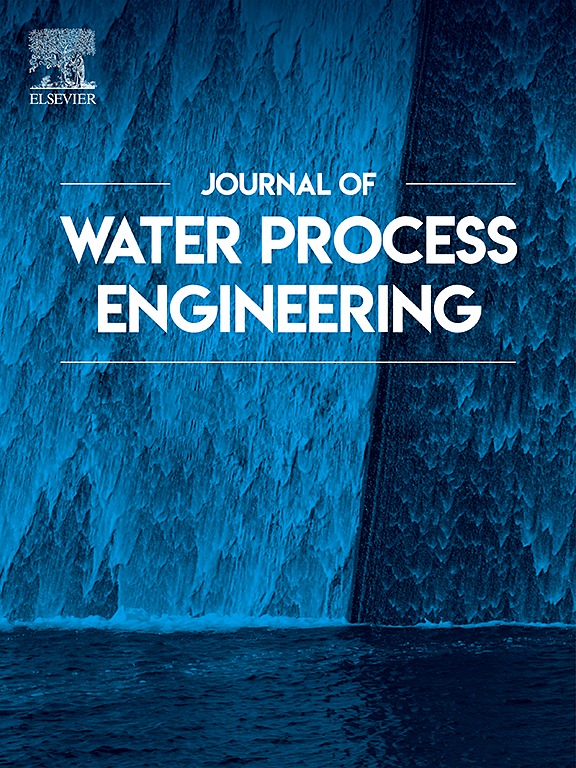Visible-light photocatalytic water purification using g-C3N4-modified NiFe2O4/K2Fe4O7 ferrite nanoceramics
IF 6.3
2区 工程技术
Q1 ENGINEERING, CHEMICAL
引用次数: 0
Abstract
Developing efficient and reusable photocatalysts responsive to visible light is important for advanced wastewater treatment. In this study, a novel ternary nanocomposite composed of graphitic carbon nitride (g-C3N4), nickel ferrite (NiFe2O4, NFO), and potassium ferrate (K2Fe4O7, KFO) was synthesized via simple wet-impregnation method. This multifunctional nanocomposite was thoroughly characterized using XRD, FTIR, SEM, EDX, XPS, BET/BJH, UV–Vis DRS, PL, and VSM to assess its structural, morphological, textural, magnetic, and optical properties. The g-C3N4/NFO/KFO composite exhibited superior photocatalytic activity under visible-light irradiation, achieving 98.57 % degradation of methylene blue (MB) with rate constant of 0.0537 min−1 and retaining over 94 % efficiency after five reuse cycles. A direct Z-scheme charge transfer mechanism was confirmed, enabling efficient separation of photogenerated charge carriers and enhancing reactive oxygen species (ROS) generation. Key parameters affecting photocatalytic performance were systematically studied. Alkaline conditions (pH 10) favored dye adsorption and ROS formation, resulting in near-complete degradation (99.94 %), while acidic pH hindered activity due to surface protonation and suppressed •OH production. Lower dye concentrations (10 mg/L) allowed optimal light penetration and access to active sites, whereas higher concentrations caused inner filter effects and reduced efficiency. Increasing photocatalyst dosage improved degradation by enhancing the availability of active sites and ROS, with optimal performance at 0.06–0.08 g/L. Moreover, the composite maintained high activity across different water sources, including lake, tap, and distilled water, demonstrating robustness in practical environments. These findings underscore the synergistic behavior of the composite components and highlight the g-C3N4/NFO/KFO nanocomposite as a promising visible-light-driven photocatalyst for real-world wastewater remediation.
用g- c3n4修饰的NiFe2O4/K2Fe4O7铁氧体纳米陶瓷进行可见光光催化水净化
开发高效、可重复利用的可见光光催化剂对污水深度处理具有重要意义。本研究采用简单的湿浸渍法合成了一种由石墨氮化碳(g-C3N4)、铁酸镍(NiFe2O4, NFO)和高铁酸钾(K2Fe4O7, KFO)组成的新型三元纳米复合材料。利用XRD、FTIR、SEM、EDX、XPS、BET/BJH、UV-Vis DRS、PL和VSM对该多功能纳米复合材料进行了全面表征,评估了其结构、形态、纹理、磁性和光学性能。g-C3N4/NFO/KFO复合材料在可见光照射下表现出优异的光催化活性,对亚甲基蓝(MB)的降解率达到98.57%,速率常数为0.0537 min−1,重复使用5次后效率保持在94%以上。证实了直接的Z-scheme电荷转移机制,使光生成的载流子有效分离,并增强了活性氧(ROS)的生成。系统地研究了影响光催化性能的关键参数。碱性条件(pH 10)有利于染料吸附和ROS形成,导致几乎完全降解(99.94%),而酸性条件由于表面质子化而阻碍活性并抑制•OH的产生。较低的染料浓度(10毫克/升)允许最佳的光穿透和进入活性位点,而较高的浓度会引起内部过滤效应并降低效率。增加光催化剂用量可通过提高活性位点和活性氧的可用性来改善降解,在0.06 ~ 0.08 g/L时性能最佳。此外,该复合材料在不同的水源(包括湖泊、自来水和蒸馏水)中保持了较高的活性,显示了在实际环境中的鲁棒性。这些发现强调了复合组分的协同行为,并突出了g-C3N4/NFO/KFO纳米复合材料作为一种有前途的可见光驱动光催化剂用于实际废水修复。
本文章由计算机程序翻译,如有差异,请以英文原文为准。
求助全文
约1分钟内获得全文
求助全文
来源期刊

Journal of water process engineering
Biochemistry, Genetics and Molecular Biology-Biotechnology
CiteScore
10.70
自引率
8.60%
发文量
846
审稿时长
24 days
期刊介绍:
The Journal of Water Process Engineering aims to publish refereed, high-quality research papers with significant novelty and impact in all areas of the engineering of water and wastewater processing . Papers on advanced and novel treatment processes and technologies are particularly welcome. The Journal considers papers in areas such as nanotechnology and biotechnology applications in water, novel oxidation and separation processes, membrane processes (except those for desalination) , catalytic processes for the removal of water contaminants, sustainable processes, water reuse and recycling, water use and wastewater minimization, integrated/hybrid technology, process modeling of water treatment and novel treatment processes. Submissions on the subject of adsorbents, including standard measurements of adsorption kinetics and equilibrium will only be considered if there is a genuine case for novelty and contribution, for example highly novel, sustainable adsorbents and their use: papers on activated carbon-type materials derived from natural matter, or surfactant-modified clays and related minerals, would not fulfil this criterion. The Journal particularly welcomes contributions involving environmentally, economically and socially sustainable technology for water treatment, including those which are energy-efficient, with minimal or no chemical consumption, and capable of water recycling and reuse that minimizes the direct disposal of wastewater to the aquatic environment. Papers that describe novel ideas for solving issues related to water quality and availability are also welcome, as are those that show the transfer of techniques from other disciplines. The Journal will consider papers dealing with processes for various water matrices including drinking water (except desalination), domestic, urban and industrial wastewaters, in addition to their residues. It is expected that the journal will be of particular relevance to chemical and process engineers working in the field. The Journal welcomes Full Text papers, Short Communications, State-of-the-Art Reviews and Letters to Editors and Case Studies
 求助内容:
求助内容: 应助结果提醒方式:
应助结果提醒方式:


